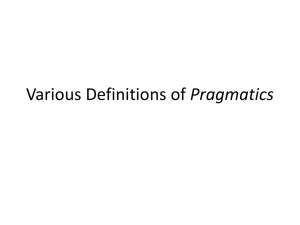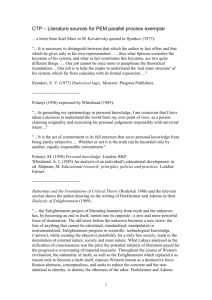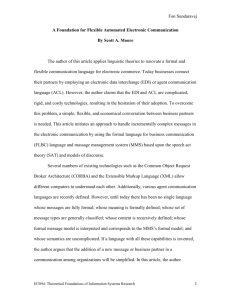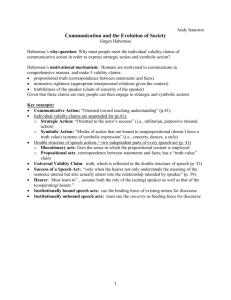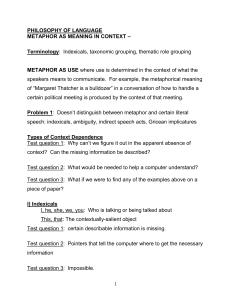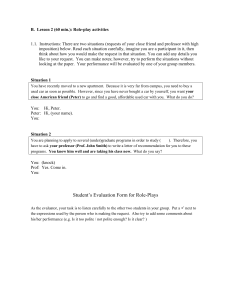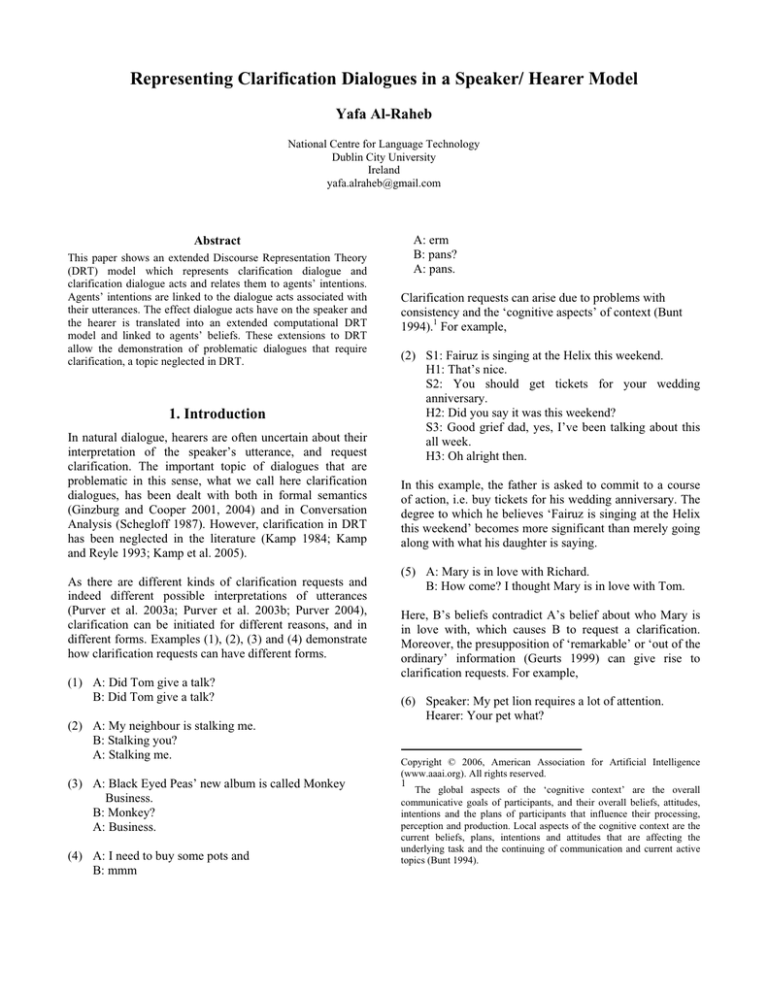
Representing Clarification Dialogues in a Speaker/ Hearer Model
Yafa Al-Raheb
National Centre for Language Technology
Dublin City University
Ireland
yafa.alraheb@gmail.com
Abstract
This paper shows an extended Discourse Representation Theory
(DRT) model which represents clarification dialogue and
clarification dialogue acts and relates them to agents’ intentions.
Agents’ intentions are linked to the dialogue acts associated with
their utterances. The effect dialogue acts have on the speaker and
the hearer is translated into an extended computational DRT
model and linked to agents’ beliefs. These extensions to DRT
allow the demonstration of problematic dialogues that require
clarification, a topic neglected in DRT.
1. Introduction
In natural dialogue, hearers are often uncertain about their
interpretation of the speaker’s utterance, and request
clarification. The important topic of dialogues that are
problematic in this sense, what we call here clarification
dialogues, has been dealt with both in formal semantics
(Ginzburg and Cooper 2001, 2004) and in Conversation
Analysis (Schegloff 1987). However, clarification in DRT
has been neglected in the literature (Kamp 1984; Kamp
and Reyle 1993; Kamp et al. 2005).
As there are different kinds of clarification requests and
indeed different possible interpretations of utterances
(Purver et al. 2003a; Purver et al. 2003b; Purver 2004),
clarification can be initiated for different reasons, and in
different forms. Examples (1), (2), (3) and (4) demonstrate
how clarification requests can have different forms.
(1) A: Did Tom give a talk?
B: Did Tom give a talk?
(2) A: My neighbour is stalking me.
B: Stalking you?
A: Stalking me.
(3) A: Black Eyed Peas’ new album is called Monkey
Business.
B: Monkey?
A: Business.
(4) A: I need to buy some pots and
B: mmm
A: erm
B: pans?
A: pans.
Clarification requests can arise due to problems with
consistency and the ‘cognitive aspects’ of context (Bunt
1994).1 For example,
(2) S1: Fairuz is singing at the Helix this weekend.
H1: That’s nice.
S2: You should get tickets for your wedding
anniversary.
H2: Did you say it was this weekend?
S3: Good grief dad, yes, I’ve been talking about this
all week.
H3: Oh alright then.
In this example, the father is asked to commit to a course
of action, i.e. buy tickets for his wedding anniversary. The
degree to which he believes ‘Fairuz is singing at the Helix
this weekend’ becomes more significant than merely going
along with what his daughter is saying.
(5) A: Mary is in love with Richard.
B: How come? I thought Mary is in love with Tom.
Here, B’s beliefs contradict A’s belief about who Mary is
in love with, which causes B to request a clarification.
Moreover, the presupposition of ‘remarkable’ or ‘out of the
ordinary’ information (Geurts 1999) can give rise to
clarification requests. For example,
(6) Speaker: My pet lion requires a lot of attention.
Hearer: Your pet what?
Copyright © 2006, American Association for Artificial Intelligence
(www.aaai.org). All rights reserved.
1
The global aspects of the ‘cognitive context’ are the overall
communicative goals of participants, and their overall beliefs, attitudes,
intentions and the plans of participants that influence their processing,
perception and production. Local aspects of the cognitive context are the
current beliefs, plans, intentions and attitudes that are affecting the
underlying task and the continuing of communication and current active
topics (Bunt 1994).
Speaker: Oh sorry, I mean one of those virtual pets
you take care of.
This time the hearer requires an explanation for the
oddness of the given information, having a pet lion.
Other reasons for clarification may deal with the ‘physical
aspects’ of the context (Bunt 1994).2 These problems have
to do with agents’ processing or perception of utterances. If
the speaker’s utterance is not clear, the hearer may ask the
speaker to clarify her statement. As a simple example,
consider a dialogue between a customer and customer
service assistant about a gas heater:
(7) Customer: How long does it take to fix my gas
heater?
Customer Service Assistant: Your what?
Customer: My gas heater needs fixing.
In example (7) the customer service assistant asks the
customer to clarify. In this particular case, the lack of
clarity may be attributed to, e.g. not hearing very well. The
hearer expects the speaker to provide an explanation,
which the speaker is then obliged to provide. If the
information is still not clear, the hearer may ask for more
clarification and the hearer needs to provide it. This is
consistent with conversation analysis research, which
assumes that information may be cleared up after an
explanation is provided, but also allows for further
clarification if needed (Schegloff et al. 1977). If the
information is clarified, then the hearer may provide
feedback that the information is clear (Bunt 2000). This
will be explored further in section 2. Lack of feedback is
also considered a form of ‘weak positive feedback’ (AlRaheb 2005). Generally, after providing an explanation,
the speaker’s assumptions are likely to be that the hearer
now has no problems with the utterance.
The following section, 2, presents the effects that
clarification dialogues and their dialogue acts (Bunt 2000)
have on agents’ beliefs. Section 3, briefly outlines the
extensions to DRT needed to represent clarification
dialogues. This is followed by a representation of a
clarification dialogue in the extended DRT format in
section 4.
2
‘Physical aspects’ of the context include, globally, physical
circumstances such as place and time and whether the communication is
face-to-face or mediated through a communicative channel and locally,
the current availability of communicative channels and the availability of
the partner at the communicative device (Bunt 1994).
2. Clarification and Agents’ Beliefs
Al-Raheb (2005) argues for the need to represent different
degrees or strengths of beliefs according to context. Beliefs
also change in response to new information. Agents in a
dialogue may form stronger beliefs as the dialogue
progresses, requiring moving the content of their weaker
beliefs to the stronger belief Discourse Representation
Structure (DRS). Furthermore, there is a further belief
state, namely, acceptance, the state in which weaker beliefs
are placed. When accepted, in this sense, clarified
information carries less weight than already believed
information.
Thus, in order to realistically model changes to beliefs, as
well as the effects of clarification dialogue acts on beliefs,
some principles of degrees of belief have been formulated.
These principles relate to both Speaker and Hearer, and are
outlined separately in the following subsections.
Hearer Degrees of Belief Principles
Principle 1: If the hearer already believes a
proposition, and the speaker produces the same
proposition, nothing changes in the hearer’s beliefs.
Principle 1 deals with the case where the hearer already has
the strong belief about the proposition the speaker is
making. In this case, when hearing the same proposition
again, the hearer’s beliefs do not change. This is somewhat
different for assertions (as distinct from presuppositions),
where the speaker may have mistakenly introduced a
proposition as an assertion (rather than as a presupposition)
and the hearer already believes the proposition.
Principle 2: If the hearer accepts a proposition, and
the speaker makes a claim that expresses the same
proposition, the hearer’s weak belief is strengthened,
and it becomes a strong belief.
Principle 2 covers the case where the hearer has previously
accepted a proposition and subsequently that proposition is
strengthened by virtue of the speaker’s making an
utterance which makes it clear that she believes the
proposition. In the extended DRT representation, the
proposition moves from the hearer’s acceptance DRS to
the hearer’s belief DRS.
Principle 3: If a proposition is uttrerd by the speaker
is new to the hearer, and the hearer decides not to
reject it, the default case is for the hearer to initially
accept it.
Principle 3 refers to the case where the hearer holds no
beliefs about the proposition prior to the speaker’s uttering
it. If the proposition is not rejected by the hearer, it is
suggested that the hearer accepts the proposition initially.
The proposal that acceptance be considered a default case
is also found in Clark and Schaefer (1989).
Principle 4: If a hearer accepts a proposition and the
proposition is used again by the speaker, the hearer
may attach more strength of belief to the proposition.
Principle 4 is called for when the hearer has initially
accepted a proposition uttered by the speaker, and the
speaker has since repeated it more than once. In this case,
the hearer may strengthen his belief about that proposition.
The principle assumed here is that the more a proposition
is repeated, the stronger its belief status for the hearer
becomes. The proposition now moves from the acceptance
DRS to the belief DRS. Generally with a new proposition,
the transition of beliefs takes place from the state of
accepting to the state of believing. In cases of clarification,
the transition takes place from the state of not believing to
the state of initially accepting then eventually believing.
Principle 4 is a very simplified rule as to how soon human
agents decide to strengthen their beliefs about new
propositions in order to make it computationally viable.
This paper does not speculate as to how that decision is
made.
It is also possible to ‘revise’ beliefs that are later doubted
by removing them from the belief DRS and adding them to
the acceptance DRS. If propositions are falsified, they can
be removed from either acceptance or belief DRSs.
Principle 5: If a hearer believes a proposition and
later utterances throw some doubt on the proposition,
the hearer can ‘downgrade’ the strength of belief to
acceptance or reject them altogether.
It is not within the scope of this paper to deal with issues
relating to trust, authority, social standing, experts, etc., all
of which affect the process of strengthening (or possibly
weakening) beliefs. For example, one is more likely to
adopt a proposition about global warming coming from an
expert on the subject than from an uneducated retired
boxer.
Speaker Degrees of Belief Principles
In dialogue it is reasonable to assume that speakers make
assumptions about their interlocutor’s belief sets. Feedback
(Bunt 2000) helps the speaker infer what the state of
beliefs of the hearer is, in particular, the degree of their
beliefs. Accordingly, this paper has developed simplified
principles, Speaker Degrees of Belief Principles, which
correspond to the Hearer Degrees of Belief Principles
outlined above.
Principle 1: If the speaker makes an utterance about a
proposition and the hearer provides no feedback, i.e.
‘weak positive feedback’, the speaker infers the
hearer accepts the proposition.
Principle 2: If the speaker makes an utterance about a
proposition and the hearer provides ‘weak positive
feedback’, e.g. ‘aha’, ‘okay’, ‘yeah’, the speaker
infers the hearer accepts the proposition.
Principle 3: If the speaker makes an utterance about a
proposition and hearer provides ‘strong positive
feedback’, e.g. ‘I totally agree’, ‘the speaker infers the
hearer believes the proposition.
Principle 4: If the speaker makes an utterance about a
proposition, which the hearer accepts, and uses more
than once in his utterances, the speaker infers the
hearer now believes the proposition.
Principle 5: If the speaker makes an utterance about a
proposition, which the hearer accepts, and then the
hearer commits him- or herself to performing an
action related to the proposition, the speaker infers
the hearer now believes the proposition.
In the DRT representation of the hearer, the proposition
moves from the hearer’s acceptance DRS to the hearer’s
belief DRS in the speaker’s representation of the hearer’s
acceptance and belief DRSs. The Principles are used as
guidelines for the speaker to make inferences about the
hearer’s state of mind. It is by no means an exact model of
how human agents make inferences about degrees of
belief, but rather a formalized approximation of this
process’s effects.
3. Extending DRT to Model Clarification
Dialogue
Two DRT variants derived from Kamp et al. (2005) are
merged and extended in order to appropriately model
clarification dialogues. The extensions to DRT model
agents’ intentions and link them to dialogue acts. DRT
structure is extended to represent different agents, their
beliefs (distinguishing ‘strong’ and ‘weak’ beliefs), their
intentions and the dialogue acts associated with their
utterances. New DRSs are created to represent the agent’s
strong beliefs and beliefs about the other agent’s beliefs,
‘Belief DRS’, as well as their intentions, ’Intention DRS’.
A new DRS is introduced to represent weaker beliefs,
called ‘Acceptance DRS’. To refer to these DRSs, new
DRS labels are added and complex conditions such as
‘attitude(i, ‘ACCEPT’, drs2)’, ‘attitude(i, ‘BEL’, drs4)’
and ‘attitude(i, ‘INT’, drs6)’ are added (cf. Figure 1). To
refer to the agent currently represented, the discourse
referent ‘i’ is used. To refer to the other agent, ‘you’ is
used. Inside DRSs, conditions are labeled according to the
information type they represent. Inside DRSs, conditions
are labeled according to the information type they
represent. Assertions are marked by ‘an’ and
presuppositions by ‘pn’ in the intention DRS. Believed
information is labeled ‘bn’ inside a belief DRS, whereas
accepted information is labeled ‘cn’ inside an acceptance
DRS. In addition, two clarification dialogue acts, namely
‘clarify’, and ‘explain’, are added to the DRT language, in
order to deal with both clarification and explanation.
The intention DRS differs from the Belief and Acceptance
DRSs in that the intention DRS directly links to the current
utterance being represented, whereas belief and acceptance
DRSs may include previous beliefs or accepted
information. This is particularly useful in that the
information represented in the intention DRS directly feeds
into the speaker’s utterance, and is then inferred by the
hearer through the linguistic utterance. The hearer’s
intention DRS includes the inferred speaker intentions in
uttering the current utterance. This gives the flexibility of
being able to model information that the hearer has
recognized but has not yet decided to accept or believe
and, is therefore, not yet included in either the belief or
acceptance DRS. This is particularly useful for modeling
clarification dialogues. For example, the hearer can
withhold judgement over an utterance if he first requires
clarification. Thus, the extended intention DRS will
include the speaker’s recognized intentions, as well as the
hearer’s intentions in asking for a clarification, without
actually having incorporated the information in question
into either the belief or acceptance DRSs when such
information is in question or being clarified. The following
section, 4, demonstrates an example of this suspended
judgment of an utterance.
Figure 1: Extended DRT
4. Clarification Dialogue: An Example
This section details an example of a misunderstanding
between two agents in a clarification dialogue, the purpose
being to illustrate the relationship between dialogue acts
and beliefs and their representation in relation to utterances
in the extended version of DRT. The dialogue
demonstrates the need for clarification as well as the
consequences of feedback in relation to the strength of
beliefs. In example (8),3 Player and Ros have different
referents in mind, which causes a misunderstanding,
resulting in the need for clarification.
(8) Player1: The old man thinks he’s in love with his
daughter.
Ros1: (appalled). Good God! We’re out of our depth
here.
Player2: No, no, no – he hasn’t got a daughter - the
old man thinks he’s in love with his daughter.
Ros2: The old man is?
Player3: Hamlet, in love with the old man’s daughter,
the old man thinks.
Ros3: Ha! It’s beginning to make sense!
(Johnstone 2002: from Rosencrantz and Guildenstern are Dead.)
3
This example is from Tom Stoppard’s, ‘Rosencrantz and
Guildenstern are dead’, which is based on Shakespeare’s Hamlet.
The following discussion focuses on the dialogue acts and
beliefs expressed by this dialogue. In the first utterance by
Player1, the speaker informs the hearer that the old man
thinks Hamlet is in love with the old man’s daughter,
think(oldMan, love(hamlet, daughter(ofOldMan))).4 In
Figure 2, drs4 shows the speaker’s beliefs, drs5 the
speaker’s beliefs about the hearer’s beliefs, and drs6 the
speaker’s intentions in making the utterance and the
immediate context of the utterance.5
However, a misunderstanding over the right referent occurs
as Ros, the hearer of Player1, wrongly recognizes the
intended referent and assumes Player1 is asserting that the
old man thinks Hamlet is in love with Hamlet’s daughter,
think(oldMan, love(hamlet, daughter(ofHamlet))). Thus, in
Figure 3, which represents Ros’s response to Player1’s
utterance, Ros believes Player believes ‘has(h, d)’ and that
‘love(h,d)’, which is the cause of Ros’s appalled reaction.
Accordingly, in Ros1, Ros indirectly asks Player to clarify.
Figure 4 shows Player’s recognition of Ros1’s utterance.
Player infers that Ros requires a clarification, which is
represented by the dialogue act used in the intention DRS,
‘clarify’. This indicates to Player that Ros has not accepted
nor believed the assertion, ‘Hamlet is in love with the old
man’s daughter’. In fact, Player infers that there is a
misunderstanding concerning who is in love with the old
man’s daughter. Player recognizes that Ros misunderstood
Player1’s assertion and Ros now believes Player believes
‘has(h, d)’ and ‘love(h, d)’, think(oldMan, love(hamlet,
daughter(ofHamlet))). This is exemplified by the
difference between Player’s beliefs, drs4, and Player’s
beliefs about Ros’s beliefs about the Player’s beliefs, drs6.
Whereas Player believes the old man thinks Hamlet is in
love with the old man’s daughter, Player believes Ros
believes Player believes the old man thinks the Hamlet is
in love with Hamlet’s daughter.
As a response, in Player2, Player attempts to ‘explain’ to
Ros that Hamlet does not have a daughter and ‘re-asserts’
that Hamlet is in love with the old man’s daughter, ‘No,
no, no – he hasn’t got a daughter – the old man thinks he’s
in love with his daughter’, think(oldMan, love(hamlet,
daughter(ofOldMan))).
4
Verbs such as ‘think’ and ‘believe’ are propositional attitudes.The
beliefs embedded under them do not necessarily reflect the speaker’s own
beliefs. This is why a sub-DRS is introduced to represent the old man’s
beliefs at this point.
5
To help demonstrate the focus of a discussion, the relevant part of a
DRS is highlighted in bold.
Figure 2: Speaker Generation: Player 1
However, the use of ‘he’ does not help Ros, who ‘clarifies’
whether it is the old man who is in love with his own
daughter: ‘The old man is?’. This time, Ros, the hearer,
associates ‘he’ in ‘he’s in love with his daughter’ with the
old man, rather than the intended ‘Hamlet’, think(oldMan,
love(oldMan,daughter(ofOldMan))).
Therefore,
Ros
believes Player2 believes ‘has(m,d)’ and ‘love(m,d)’ – ‘m’
stands for the old man in Figure 5.
Ros2 gives rise to some interesting interpretations, but, the
focus here is on the indirect request for clarification
expressed by the Ros’s shock. As Figure 5 shows, Ros has
not accepted or believed that the old man is in love with his
own daughter by virtue of the propositions not being in
either the acceptance or the belief DRS. However, Ros
believes that Player believes the old man thinks he is in
love with his own daughter, drs5. Consequently, Ros
requires a clarification for the oddness of the assertion.
either the acceptance or the belief DRS. However, Ros
believes that Player believes the old man thinks he is in
love with his own daughter, drs5. Consequently, Ros
requires a clarification for the oddness of the assertion.
Figure 4: Hearer Recognition: Ros 1
Figure 3: Speaker Generation: Ros 1
Ros2 gives rise to some interesting interpretations, but, the
focus here is on the indirect request for clarification
expressed by the Ros’s shock. As Figure 5 shows, Ros has
not accepted or believed that the old man is in love with his
own daughter by virtue of the propositions not being in
Player recognizes that Ros believes Player believes
think(oldMan, love(oldMan, daughter(ofOldMan))) in
figure 6. This is demonstrated in drs6 and drs6a by
‘has(m,d)’ and ‘love(m,d)’. Consequently, Player, in
Player3, ‘re-asserts’ that it is Hamlet, this time saying
‘Hamlet’ instead of ‘he’, in order to ‘explain’ to Ros that it
was Hamlet and not the old man who is in love.
Figure 5: Speaker Generation: Ros 2
Figure 7, represents Player’s recognition of Ros3. Ros
indicates to Player that he finally understands and the
message is clear. However, Ros does not commit to more
than receiving the message correctly, which is why this is
considered a case of ‘weak positive feedback’. The
dialogue act, ‘weak positive feedback’ is added to the
intention DRS, which represents Player’s inferred intention
of Ros’s utterance and the immediate context represented
by that utterance. In accordance with Speaker degrees of
belief principles, principle 1, Player now infers Ros
accepts rather than believes that the old man thinks Hamlet
is in love with the old man’s daughter and adds this to
Ros’s acceptance DRS, drs3. Now that the
misunderstanding is cleared, the agents in the dialogue can
resume talking about the topic of the dialogue, which is
Hamlet’s assumed love for the old man’s daughter.
Figure 6: Hearer Recognition: Ros 2
5. Conclusion and Future Work
This paper presented a computational extension of DRT in
order to represent clarification dialogues. New DRSs to
model agents’ beliefs, intentions, background and current
context were introduced which required extending the
DRT language to accommodate these extensions. The
extended DRT employs implementable degrees of beliefs
for agents involved in clarification dialogues, which
demonstrate the link between agents’ intentions and beliefs
and dialogue acts.
Bunt, H. 2000. ‘Dynamic Interpretation and Dialogue Theory’.
In: M. Taylor, F. Neel, and D. Bouwhuis (Eds.). The Structure of
Multimodal Dialogue, Volume 2. pp. 139–166. Amsterdam: John
Benjamins.
Clark, H. and Schaefer, E. 1989. ‘Contributing to Discourse’.
Cognitive Science 13, pp. 259–294.
Geurts, B. 1999. Presuppositions and Pronouns: Current
Research in the Semantics/ Pragmatics Interface. Oxford:
Elsevier.
Ginzburg, J. and Cooper, R. 2001. ‘Resolving Ellipsis in
Clarification’. In: Proceedings of the 39th Meeting of the ACL.
pp. 236–243. Association for Computational Linguistics.
Ginzburg, J. and Cooper, R. 2004. ‘Clarification, Ellipsis, and the
Nature of Contexual Updates’. Linguistics and Philosophy 27, pp.
297-366.
Johnstone, B. 2002. Discourse Analysis. Oxford: Blackwell.
Kamp, H. 1984. ‘A Theory of Truth and Semantic
Representation’. In: J. Groenendijk, T. Janseen, and M. Stokhof
(Eds.). Truth, Interpretation and Information: Selected Papers
from the Third Amsterdam Colloquium. Amsterdam: Foris
Publications.
Kamp, H. and Reyle, U. 1993. From Discourse to Logic:
Introduction to Model Theoretic Semantics of Natural Language,
Formal Logic and Discourse Representation Theory. Boston,
Dordrecht: Kluwer.
Kamp, H., van Genabith, J., and Reyle, U. 2005. The Handbook
of Logic. Unpublished Manuscript. http://www.ims.unistuttgart.de/˜hans/.
Purver, M. 2004. ‘Claire: the Clarification Engine’. In: J.
Ginzburg and E. Vallduvi (Eds.). Proceedings of the Eighth
Workshop on the Semantics and Pragmatics of Dialogue. Catalog
‘04. pp. 77-84. Universitat Pompeu Fabra: Barcelona.
Purver, M., Ginzburg, J., and Healey, P. 2003a. ‘On the Means
for Clarification in Dialogue’. In: van Kuppevelt and R. Smith
(Eds.). Current and New Directions in Discourse and Dialogue
(Text, Speech and Language Technology series vol 22). pp. 235–
255. Boston, Dordrecht: Kluwer.
Figure 7: Hearer Recognition: Ros 3
References
Al-Raheb, Y. 2005. Speaker/Hearer Representation in a
Discourse Representation Theory Model of resupposition: A
Computational-Linguistic Approach. Phd. University of East
Anglia.
Bunt, H. 1994. ‘Context and Dialogue Control’. THINK
Quarterly 3, 19–31.
Purver, M., Healey, P., King, J., Ginzburg, J., and Mills, G.
2003b. ‘Answering Clarification Questions’. In: Proceedings of
the 4th SIGdial Workshop on Discourse and Dialogue,
Association for Computational Linguistics. pp. 23–33. Sapporo.
Schegloff, E., Jefferson, G., and Sacks, H. 1977. ‘The Preference
for Self-Correction in the Organization of Repair in
Conversation’. Language 53, pp. 361–382.
Schegloff, E. 1987. ‘Some Sources of Misunderstanding in Talkin-interaction’. Linguistics 25, pp. 201–218.

